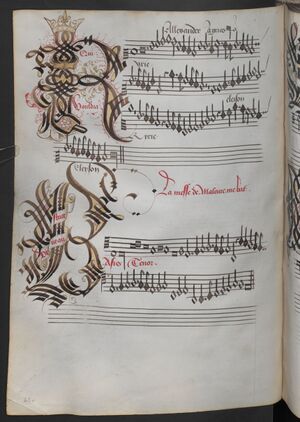ألكسندر أجريكولا
ألكسندر أجريكولا Alexander Agricola (1445 أو 1446 - 1506) موسيقي من المدرسة الفرانكو -فلامنكية في عصر النهضة. عضو بارز من الإبرشية الكبرى وكتب الموسيقى في جميع الأشكال الموسيقية الدينية والدنيوية الهامة في عصره.
A prominent member of the Grande chapelle, the Habsburg musical establishment, he was a renowned composer in the years around 1500, and his music was widely distributed throughout Europe. He composed music in all of the important sacred and secular styles of the time.[1]
حياته
وُلِد ألكسندر أجريكولا بإسم الكسندر أكرمان. كان ابنا غير شرعيا لسيدة اعمال هولندية ثرية كان اجريكولا مؤلف مشهور دوليا في 1490. عمل في البلاط وكنائس إيطاليا وفرنسا والدول الدنيا حيث كان الطلب عليه كافي ليحدد اجره الخاص. فنيا قداساته والموتيت والأغنيات الدنيوية والمقطوعات الآلية التي تعكس تأثير أوكاجيم تنطبق على عصره لكن السمة المكثفة والقلقة لموسيقاه وصفها البعض من معاصريه بأنها "مجنونة وغريبة".
النمط الموسيقي
المدارس والملحنون ذوي الصلة
Agricola is one of the few transitional figures between the Burgundian School and the style of the Josquin generation of Netherlanders who actually wrote music in both styles.
Agricola's style is related to that of Johannes Ockeghem, especially early in his career, and towards the end of his life he was writing using the pervasive imitation characteristic of Josquin des Prez. While few of his works can be dated precisely, he does use many of the non-imitative, complex, rhythmically diverse contrapuntal procedures more often associated with Ockeghem. Unlike Ockeghem, however, he was willing to employ repetition, sequence, and florid imitation in the manner of the other composers who were working around 1500 when the technique became widespread.
الأصناف
Agricola wrote masses, motets, motet-chansons, secular songs in the prevailing formes fixes such as rondeaux and bergerettes, other chansons, and instrumental music. Much of his instrumental music was based on secular music by Gilles Binchois or Ockeghem. Many of these pieces had become quite popular in the late 15th century.
Compositional hallmarks
Above all the variants in his general musical style over his working life, Agricola himself wrote in a highly distinctive style, taking the mysteriously sinuous lines of Ockeghem as his point of departure. His music is often very busy and highly detailed, with repeated sequence, repetition of terse rhythmic and motivic units, and a desire to usurp the underlying pulse, sometimes seeming to border on the perverse, either by prolonging cadential figures to cadence on the "wrong" beat, or by shifting the metrical beat of some parts against others. As an example, the closing Agnus Dei of his unusually extended Missa 'In myne zin' features the cantus firmus stated in equal notes of eleven minims duration each in first statement, followed by a statement of five minims duration each, or in the second Salve Regina setting, offsetting part of the statement of the cantus firmus by a quaver for its entire duration, in both cases with the other voices proceeding in a more strict quadruple meter above.
Other "games" played in the music include posing puzzles of mode and musica ficta for the performers (e.g. the Kyrie of the Missa Le serviteur plays with the expectations of the very well known plainchant cantus firmus by setting up some knotty issues of the implied possibility of modal inflection with consistent extra flats.) The music is characteristically athletic in all voice parts, with the lower parts in particular featuring much that requires very fine singers, and not representing the normal simply harmonic function of the tenor-bass combinations used by most of his contemporaries. Often a highly elaborate set of quick motifs will spring unexpected from a previous slow-moving texture (e.g. the eruption of detailed duos beginning at Glorificamus te and climaxing at Adoramus te in the Gloria of the Missa in myne zin).
His music was very highly regarded in its day, the very distinctive style leading to one contemporary commentator referring to it as "crazy", and another as "sublime".
الأجريكولات الآخرون
There are other composers named Agricola who are sometimes confused with Alexander:
- مارتن أجريكولا (1486–1556; famous mainly as a theorist and teacher)
- يوهانس أجريكولا (1494–1566), German Protestant reformer and humanist
- Johann Agricola Eisleben junior (before 1560–1594)
- Wolfgang Christoph Agricola (ح. 1600)
- يوهان پول أگريكولا (1638 أو 1639–1697)
- Georg Ludwig Agricola (1643–1676; also an important writer)
- Johann Friedrich Agricola (1720–1774; also a musicographer, organist and singing master)
Notes
- ^ Wegman/Fitch, Grove online
References
- Reese, Gustave (1954). Music in the Renaissance. New York: W. W. Norton & Company. ISBN 978-0-393-09530-2.
- Wegman, Rob; Fitch, Fabrice. L. Macy (ed.). Alexander Agricola. Grove Music Online. Archived from the original on 16 May 2008. Retrieved 28 October 2010.(يتطلب اشتراك)
- Edward R. Lerner, "Alexander Agricola." The New Grove Dictionary of Music and Musicians, ed. Stanley Sadie. 20 vol. London, Macmillan Publishers Ltd., 1980. (ISBN 978-1-56159-174-9)
- Honey Meconi, Pierre de la Rue and Musical Life at the Habsburg-Burgundian Court. Oxford, Oxford University Press. 2003. ISBN 978-0-19-816554-5
وصلات خارجية
- Free access to high-resolution images of manuscripts containing works by this composer from Digital Image Archive of Medieval Music
- Free scores by ألكسندر أجريكولا at the International Music Score Library Project
- صفحات بها خطأ في تحويل الحرز
- Pages which use score
- Short description is different from Wikidata
- Articles with hatnote templates targeting a nonexistent page
- صفحات تحتوي روابط لمحتوى للمشتركين فقط
- مواليد عقد 1440
- وفيات 1506
- مؤلفون موسيقيون من المدرسة الفرانكو-فلمنكية
- مؤلفون موسيقيون من عصر النهضة
- وفيات بالطاعون في القرن 16
- Infectious disease deaths in Spain
